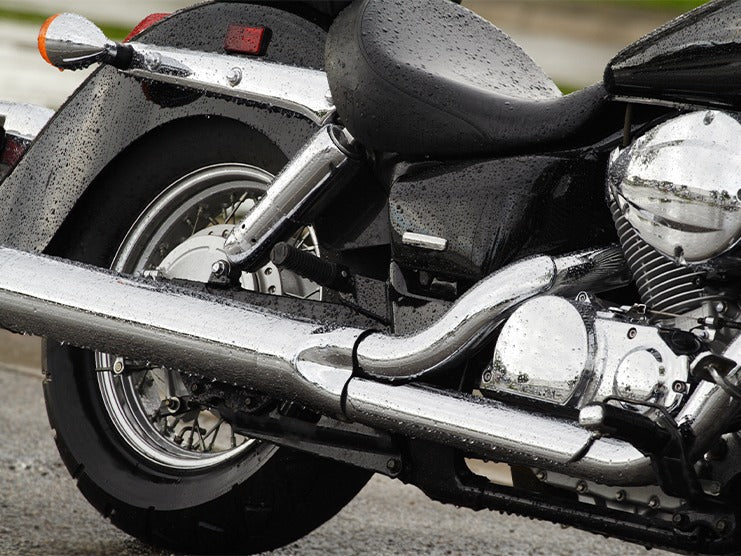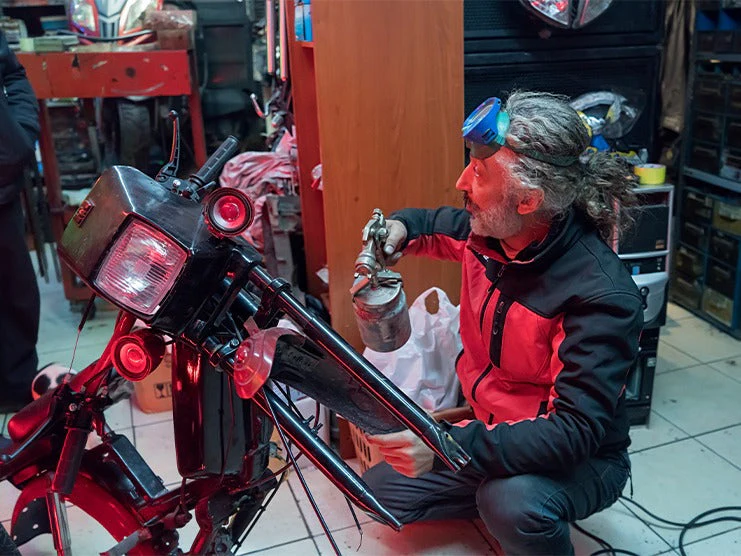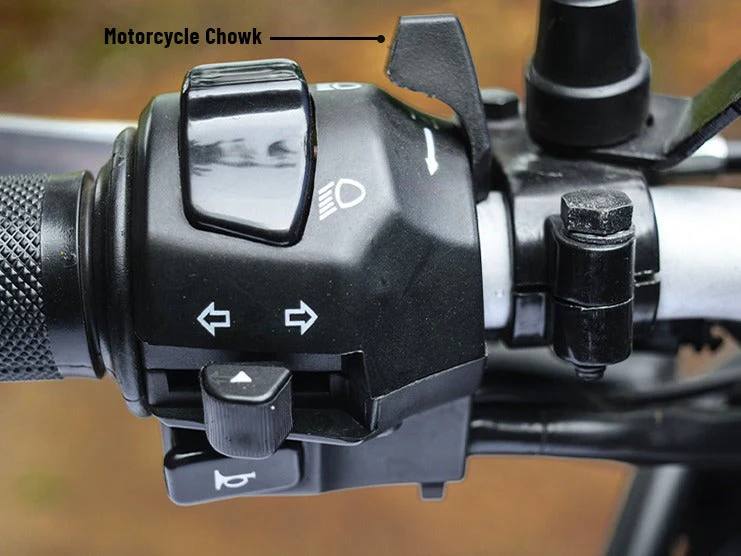Table of Content
Riding a motorcycle in the rain can be a challenging and hazardous experience for the rider and motorcycle. Wet roads can be slippery, reducing traction and control. Rain can also damage the motorcycle's engine, electrical components, and other parts. However, with the correct preparation and precautions, riding a motorcycle safely in the rain is possible.
This guide will explore the risks of riding a motorcycle in the rain, the precautions you can take to protect yourself and your motorcycle, and how to ride safely in wet conditions. Whether you're an experienced or novice rider, knowing how to ride in the rain can help you enjoy motorcycle riding in any weather.
1. Is Rainwater Bad for Motorcycle Engines?
Rainwater is not necessarily harmful to a motorcycle engine, but it can cause issues if it gets into certain areas of the motorcycle. For example, rainwater entering the air intake or carburetor can mix with the fuel and cause engine combustion problems. Similarly, if water gets into the exhaust system, it can cause corrosion and rust. Also, if rainwater accumulates in certain areas, such as the spark plug wells, it can cause electrical problems and damage the engine.
It is important to protect the motorcycle from rainwater when not in use by storing it in a garage or under a waterproof cover. If you have to ride in the rain, it is best to avoid riding in deep puddles, try reducing speed and sudden movements to prevent splashing, and drying the bike thoroughly after riding.
2. Does Water Affect Motorcycle Parts?

Yes, water can affect motorcycle parts, especially if the bike is wet for extended periods or frequently ridden on wet roads. Leaving a motorcycle in the rain for extended periods can affect the bike's performance and overall condition. Here are ways that water can affect motorcycle parts:
Corrosion
Water contains minerals and contaminants that can cause corrosion on metal motorcycle parts, such as the frame, exhaust system, and fasteners. Over time, corrosion can weaken the metal and cause it to break.
Electrical Issues
Water can damage electrical components on the motorcycle, such as the battery, wiring, and ignition system. This can result in starting problems, battery drain, or even total failure of the electrical system.
Brake Performance
Wet brakes can reduce stopping power and increase stopping distance, making it harder to brake quickly and safely. This can be especially dangerous when riding on slippery surfaces.
Tire Condition
Riding on wet roads can cause the tires to wear out faster and reduce traction, increasing the risk of accidents. Additionally, water can seep into the tire valves, leading to slow leaks or becoming flat.
Mold and Mildew
Moisture can accumulate on the motorcycle's non-metallic parts, such as the seat and handlebars, creating a breeding ground for mold and mildew. This can lead to unpleasant odors, staining, and damage to the upholstery and other non-metallic materials.
3. Can You Leave Your Motorcycle in the Rain?
While it's usually best to avoid leaving a motorcycle in the rain for extended periods, you can do so if necessary. However, there are several precautions you should take to minimize the risk of damage to the bike.
If you have to leave your motorcycle in the rain, there are precautions you can take to minimize the risk of water damage to your bike:
Cover the Motorcycle
Use a waterproof cover to protect the bike from rain. Make sure the cover is securely fastened to prevent water from seeping in.
Park on a Level Surface
Park the motorcycle on a level surface to prevent water from pooling around the bike's tires or other components.
Keep the Motorcycle Elevated
If possible, park the motorcycle on a stand or an elevated surface to keep it off the ground and prevent water from pooling around the bike.
Check the Weather Forecast
If the weather forecast indicates a high probability of rain, place your motorcycle in a covered space before the rain arrives. If you're caught in a sudden downpour, try to find shelter or cover the bike as soon as possible.
Dry the Motorcycle After Riding in the Rain
If you've been riding in the rain, take the time to dry the motorcycle thoroughly when you get home. Use a soft cloth or towel to wipe down the bike's metal components and electrical connections, and allow the bike to air dry completely before storing it.
Park in a Dry, Covered Area
If you have access to a garage, carport, or any covered area, park your motorcycle there to protect it from rain. If you don't have access to a covered area, try to park the motorcycle under a tree or any place with a roof.
Use a Center Stand or Paddock Stand
A center stand or paddock stand can help elevate the motorcycle and keep the wheels off the ground, reducing the risk of water damage to the tires, brakes, and other components.
Protect the Electrical Components
To prevent water from damaging any electrical components, make sure to cover the battery and other electrical connections with a plastic bag or waterproof material.
Taking precautions can help protect your motorcycle from water damage if you have to leave it in the rain. However, it's important to note that the best way to avoid water damage is to store the motorcycle in a dry, covered area when not in use, especially if you live in an area with frequent rain or other inclement weather.
3.1 Why You Should Not Leave Your Motorcycle in the Rain
Leaving a motorcycle in the rain has potential risks, including:
| Risks of Leaving Your Motorcycle in the Rain | ||
|---|---|---|
| Sr. no. | Risk | Description |
| 1 | Rust | Water can cause metal parts to rust and corrode, weakening the bike's structural integrity. |
| 2 | Fading and Discoloration | The paint and finish on the bike can fade and become discolored over time if exposed to rain. |
| 3 | Slippery Surfaces | Rain can create slippery surfaces on roads and parking lots, making it more difficult to control and maneuver the bike. |
| 4 | Wet Brakes | Wet brakes can be less effective, making it harder to stop the bike quickly. |
| 5 | Soggy Seat | Rain can saturate the seat, making it uncomfortable to ride and potentially damage the padding and cover. |
| 6 | Water in the Fuel Tank | Water can get into the fuel tank, which can disrupt the fuel system. |
| 7 | Water in the Engine | If water gets into the engine, it could damage the engine components and prevent the bike from running. |
| 8 | Damaged Tires | Wet tires can lose traction, and water can damage the rubber and weaken the tires over time. |
| 9 | Corroded Exhaust | Rain can cause the exhaust system to become rusted or corroded, damaging the pipes and reducing performance. |
| 10 | Stuck Throttle | Water can get into the throttle and cause it to become stuck, which can be dangerous on the road and result in an accident. |
| 11 | Waterlogged Air Filter | Water can get into the air filter, restricting airflow to the engine and reducing performance. |
| 12 | Contaminated Oil | Water can also get into the oil, which can cause it to become contaminated and less effective at lubricating the engine. |
| 13 | Damage to Delicate Parts | Rain can damage parts like the spark plug, carburetor, and other engine components, leading to performance problems and costly repairs. |
| 14 | Theft | A bike left in the rain may be more vulnerable to theft, as it may be easier for thieves to tamper with or move the bike parked in a wet and deserted area. |
4. Are Cruisers More Vulnerable to Rainwater than Dirt Bikes?
Cruisers and dirt bikes can be vulnerable to water damage if the proper precautions are not taken. However, some factors can make cruisers more susceptible to damage than dirt bikes. Cruisers generally have more exposed electrical components, such as the battery and ignition system. They also tend to have larger and heavier components, such as the engine and exhaust system, that are more difficult to protect from water damage.
On the other hand, dirt bikes are designed to handle more extreme conditions, including riding in wet and muddy environments. They often have more protection for their electrical components, such as waterproof wiring and sealed connectors. Additionally, dirt bikes are typically more maneuverable and can be ridden at slower speeds, which can help riders avoid large puddles and other hazards.
5. Is it Safe to Ride a Motorcycle in the Rain?

You can make riding a motorcycle in the rain safer if you take the necessary precautions and adjust your riding style to better suit the wet conditions. However, it’s important to be aware that riding in the rain has a higher risk of accidents and can be more dangerous.
Here are some tips to help you ride safely in the rain:
Wear Appropriate Gear
Wear a waterproof jacket, pants, gloves, and boots to keep yourself dry and comfortable in the rain. Consider wearing a full-face helmet with a clear visor to improve visibility.
Slow Down
Wet roads can reduce traction and increase the risk of slipping or skidding, so it's important to slow down. Reduce your speed and give yourself plenty of space to brake and maneuver.
Be Visible
Rain can reduce visibility, so wear bright, reflective clothing and use your motorcycle's headlights and taillights to increase your visibility to other drivers.
Avoid Standing Water
Puddles and standing water can hide potholes, debris, and other hazards, so try to avoid them if possible.
Be Gentle on the Controls
Smooth, gradual movements will help you maintain control in wet conditions. Avoid sudden acceleration or braking, and use gentle, gradual movements when steering and braking.
Check Your Tires
Make sure your tires have good treads and are properly inflated to maintain traction on wet roads. Switching to rain tires, which have deeper treads and provide better grip in wet conditions, is also a good idea.
Stay Alert
Watch the road for hazards, such as standing water, potholes, or debris. Use your peripheral vision to scan for cars or pedestrians obscured by the rain.
Plan Your Route
Avoid low-lying areas or areas prone to flooding. Instead, choose routes with good drainage and minimal traffic. If possible, wait for the rain to stop or lighten before riding.
Following these tips and using your best judgment can help you ride a motorcycle safely in the rain. However, if the conditions are severe, such as during a heavy storm or flood, it may be best to avoid riding altogether and wait for the weather to improve.
5.1 Dangers of Riding a Motorcycle in the Rain
Here are potential dangers of riding your motorcycle in the rain:
| Dangers of Riding in the Rain | ||
|---|---|---|
| Sr. no. | Danger | Description |
| 1 | Reduced Visibility | Rain can reduce visibility, making it harder to see the road and other vehicles. It can also make it difficult for other drivers to see you. |
| 2 | Slippery Roads | Wet roads can be slippery, reducing traction and increasing the risk of skidding or sliding. |
| 3 | Hydroplaning | Hydroplaning occurs when the motorcycle's tires lose contact with the road surface and ride on top of a layer of water, reducing control of the motorcycle. |
| 4 | Reduced Braking | Wet brakes can be less effective, requiring longer stopping distances and increasing the risk of accidents. |
| 5 | Reduced Tire Grip | Wet tires can have reduced grip, making it harder to control the motorcycle and maneuver around obstacles. |
| 6 | Increased Braking Distance | Wet road conditions require increasing stopping distance when riding a motorcycle. |
| 8 | Reduced Stability | Wet conditions can reduce the motorcycle's stability, making it harder to maintain balance and control. |
| 10 | Water Damage | Water can damage the motorcycle's engine, electrical components, and other parts, leading to costly repairs. |
| 11 | Poor Road Conditions | Rain can wash gravel, sand, and other debris onto the road, creating hazardous road conditions. |
| 12 | Reduced Road Markings | Rain can make road markings less visible, making it harder to navigate roads and intersections. |
| 14 | Decreased Riding Comfort | Riding in wet conditions can be uncomfortable, increasing fatigue and making it difficult for riders to concentrate. |
| 15 | Increased Risk of Accidents | Reduced visibility, slippery roads, and reduced motorcycle control can increase the risk of accidents in wet conditions. |
You can ride a motorcycle safely in the rain by being mindful of your surroundings and taking appropriate precautions, such as adjusting your riding style and wearing appropriate gear.
6. Do Fairings Help with Riding in the Rain?
Fairings can help with riding in the rain since they reduce wind resistance and shield the rider’s face from rain, making it easier to control the motorcycle in wet conditions. Here are some ways that fairings can help:
6.1 Rain and Wind Protection
Fairings can help deflect wind and rain away from the rider, reducing the amount of water that hits the rider and making it easier to see and control the motorcycle.
6.2 Aerodynamics
Fairings can improve the motorcycle's aerodynamics, reducing wind resistance and making it easier to control at higher speeds.
6.3 Protection for Components
Fairings can protect the motorcycle's components vulnerable to water damage, such as the engine, exhaust system, and electrical connections.
7. Conclusion
Leaving a motorcycle in the rain can cause the motorcycle to become damaged. However, by taking appropriate precautions, you can minimize the risks and ride safely in wet conditions. It's also important to consider the benefits and drawbacks of fairings and other protective gear and choose a motorcycle suited for riding in rainy weather. By being aware of potential dangers and taking proactive steps to mitigate them, you can enjoy the freedom and excitement of riding a motorcycle, even in rainy weather. If you want to buy the best motorcycle luggage and parts, you can check Viking bags to get saddlebags, crash bars, sissy bars, fairings, sissy bar bags, and handlebars.













Leave a comment
All comments are moderated before being published.
This site is protected by hCaptcha and the hCaptcha Privacy Policy and Terms of Service apply.